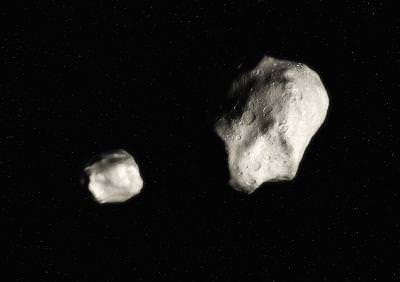[/caption]
From a University of Colorado-Boulder press release:
While the common perception of asteroids is that they are giant rocks lumbering about in orbit, a new study shows they actually are constantly changing “little worlds” that can give birth to smaller asteroids that split off to start their own lives as they circle around the sun.
Astronomers have known that small asteroids get “spun up” to fast rotation rates by sunlight falling on them, much like propellers in the wind. The new results show when asteroids spin fast enough, they can undergo “rotational fission,” splitting into two pieces which then begin orbiting each other. Such “binary asteroids” are fairly common in the solar system.
An international team of astronomers led by Petr Pravec of the Astronomical Institute in the Czech Republic found that many of these binary asteroids do not remain bound to each other but escape, forming two asteroids in orbit around the sun when there previously was just one. The study appears in the Aug. 26 issue of Nature.
The researchers studied 35 so-called “asteroid pairs,” separate asteroids in orbit around the sun that have come close to each other at some point in the past million years — usually within a few miles, or kilometers — at very low relative speeds. They measured the relative brightness of each asteroid pair, which correlates to its size, and determined the spin rates of the asteroid pairs using a technique known as photometry.
“It was clear to us then that just computing orbits of the paired asteroids was not sufficient to understand their origin,” said Pravec. “We had to study the properties of the bodies. We used photometric techniques that allowed us to determine their rotation rates and study their relative sizes.”
The research team showed that all of the asteroid pairs in the study had a specific relationship between the larger and smaller members, with the smallest one always less than 60 percent of the size of its companion asteroid.
The conclusion fits a theory of binary asteroid formation originated by co-author Daniel Scheeres, from the University of Colorado, Boulder. His theory predicts that if a binary asteroid forms by rotational fission, the two can only escape from each other if the smaller one is less than 60 percent the size of the larger asteroid. Of all the asteroid pairs in the study, the smallest of each pair was always less than 60 percent of the mass of its companion asteroid.
Scheeres’ theory predicts that if a binary asteroid forms by rotational fission, the two can only escape from each other if the smaller one is less than 60 percent of the size of the larger asteroid. When one of the asteroids in the pair is small enough, it can “make a break for it” and escape the orbital dance, essentially moving away to start its own “asteroid family,” he said. During rotational fission, the asteroids separate gently from each other at relatively low velocities.
“This is perhaps the clearest observational evidence that asteroids aren’t just large rocks in orbit about the sun that keep the same shape over time,” said Scheeres. “Instead, they are little worlds that may be constantly changing as they grow older, sometimes giving birth to smaller asteroids that then start their own life in orbit around the sun.”
Read more at the University of Colorado-Boulder.


I am not sure, but maybe these could be used to test MOND theories. The tiny gravitational potentials and motions under small forces could be used to test ideas of deviations of Newton’s laws with small accelerations.
LC